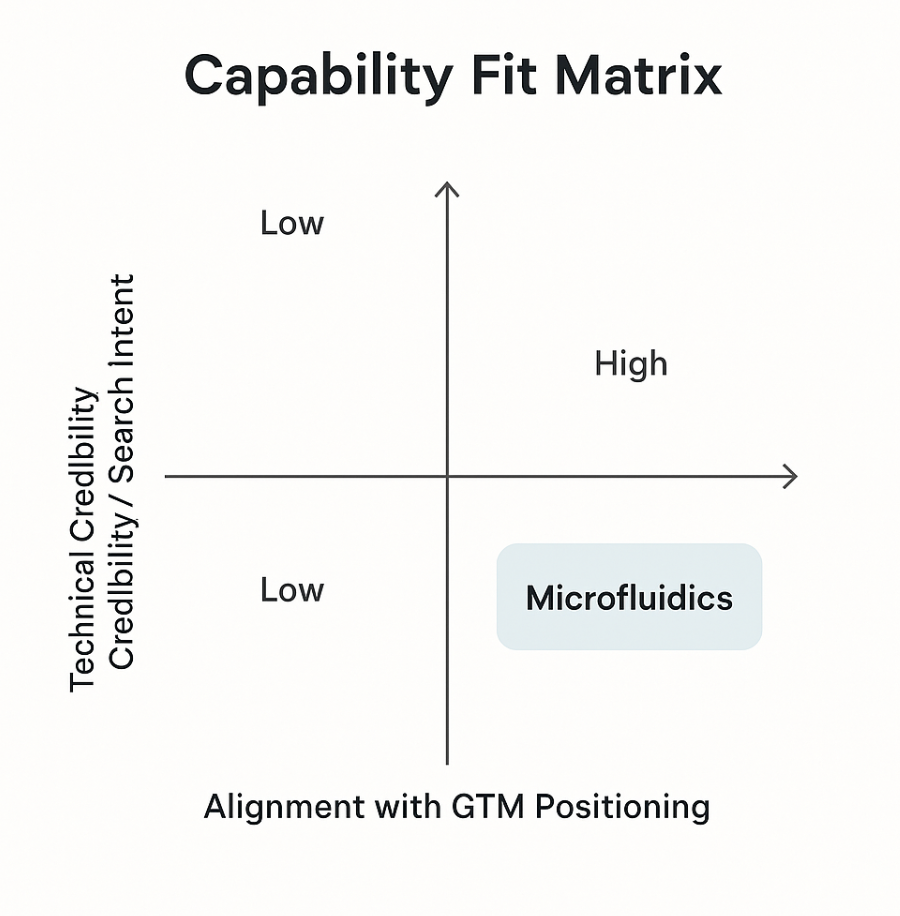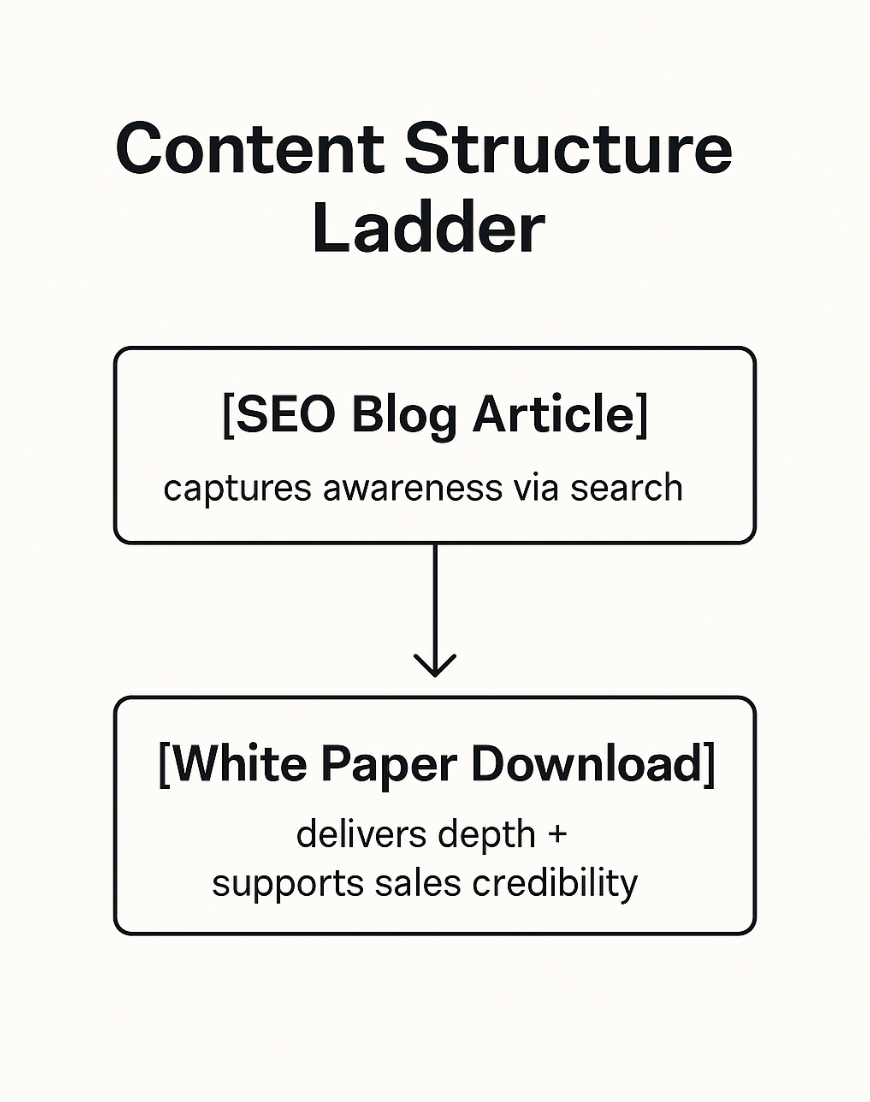How to Turn Niche Technical Expertise Into a High-Intent Content Asset
Niche content doesn’t scale wide, but it can go deep where it counts.
Not all service offerings belong in your content strategy. But some, when they offer true market differentiation, span sectors, and tie directly to buyer risk, deserve targeted investment. This post walks through how we recognized IP management as one of those rare capabilities, and how we built a content initiative around it that supports our go-to-market positioning without reverting to a transactional service-selling narrative.
Don’t treat every service equally. Invest content only where there's real GTM differentiation.
Spot strategic exceptions. Cross-sector value + buyer risk + rarity = a signal worth surfacing.
Frame it beyond the service. Shift the narrative from “what we offer” to “how we reduce risk.”
Build for credibility. Pair reframing content (blog) with depth content (white paper) to earn trust and capture leads.
When your company has deep technical capabilities, it’s tempting to avoid writing about them—especially if they don’t obviously support your GTM motion. But niche technical expertise can become a high-intent content asset when it’s shaped strategically: designed for the right audience, gated appropriately, and connected to the broader content system.This post breaks down how we used Delve’s microfluidics expertise to do exactly that.
Use a framework to evaluate whether technical capabilities support GTM positioning
If the audience is small but high-intent, niche content can deliver big returns
Content structure matters, so pair SEO-friendly surface content with deeper gated assets
Tone should match audience expectations (especially technical buyers)
When a Capability Isn’t a Campaign
Delve is a strategic development partner for companies building complex products in medtech, diagnostics, robotics, and more. Our team spans deep technical capabilities, from digital UX to electro-mechanical engineering to microfluidics R&D.
But content decisions aren’t just about showing what we can do.
When our team started discussing content around our microfluidics work, we paused. Yes, it’s a real strength. But does promoting it support our go-to-market positioning? Or would it dilute the broader message we’re building: that Delve is a full-spectrum partner, not just a specialist vendor?
This is where strategic content leadership matters. We weren’t asking, “Can we write about microfluidics?” We were asking:
Should we?
And if so, how?
How We Used Our Framework to Define the Right Fit
Delve’s content strategy isn’t driven by topics. It’s driven by the role content plays in supporting GTM execution. Every potential piece is evaluated through a layered framework:
Does this content reinforce our core positioning as a strategic partner?
Which audience is it for, and where in the funnel do they need support?
What job is this asset doing (awareness, trust-building, sales enablement)?
Does this piece have long-term utility or repurposing value?
Microfluidics didn’t check the “tentpole campaign” box. It wasn’t a front-door entry point for most of our target buyers. But it did meet other key criteria:
Strong SEO opportunity for high-intent technical search terms
Valuable trust-building signal for technical buyers and engineering partners
Shows depth and cross-functional capability for diagnostics clients
So we greenlit it, but with constraints.
Two Layers, One Job: Capturing Intent and Proving Credibility
We structured the content deliberately:
A short teaser blog that introduced the relevance of microfluidics in diagnostics, optimized for SEO and awareness
A gated white paper that dug into the ten biggest engineering challenges—and how our team approaches them
This let us:
Earn organic traffic without overwhelming casual readers
Deliver real depth to those who wanted it
Keep the white paper available as a trust-builder for sales, even if it wasn’t part of a major campaign
Why This Content Worked, Without Being Flashy
This wasn’t a content “hero.” It didn’t fuel a launch campaign or a press push.
But it worked because it was:
Strategically restrained: We didn’t over-promote or misposition it
Functionally layered: Each asset had a job, and we kept the audience in mind
Voice-aligned: It earned trust by sounding like the smart, technical team we are
Reusable: The white paper now lives in sales decks, proposal references, and more
More importantly, this project reinforced a key message to our internal team:
Even niche capabilities have a role in content, when the role is clear.
This wasn’t just smart packaging. It was a strategic choice to invest in a high-complexity topic because we knew it would resonate with a small but critical audience. Not everything needs to scale. But when a niche capability aligns with GTM goals, it can become a powerful credibility asset.
How to Make Niche Expertise Work Harder in Your Content Strategy
Not everything should be a campaign. Sometimes niche expertise deserves content, not promotion. The key is evaluating its GTM fit first.
Structure is strategy. Use layers that serve different jobs: blog for awareness, white paper for trust and sales support.
Frameworks filter the noise. A GTM-aligned evaluation matrix helps teams decide when a technical topic deserves investment.
Tone = trust. Content for technical audiences should reflect their depth and rigor. Marketing polish can backfire.
Content is part of the system. Even a niche piece should reinforce the company’s broader positioning, especially when shared in sales or embedded in proposals.
See This Content Strategy in Action
Want to see how we positioned a niche technical capability as part of a GTM-aligned content system?
Read the teaser blog post on microfluidics
Download the full white paper: Solving the 10 Biggest Microfluidics Challenges in Diagnostics Development
About Me
I lead content strategy for B2B brands that need high-leverage assets—not just volume. I specialize in aligning storytelling with go-to-market priorities and executing strategic content systems end to end.
This blog is part of a series on building GTM-aligned content that works harder. The example in this post is based on work I led at Delve, where I developed content frameworks to evaluate when and how niche technical capabilities, like microfluidics, can support a broader positioning strategy without slipping back into tactical service promotion.
Explore the full series.

